by Editor | Feb 25, 2013 | Food
By Elena del Valle
Photos by Gary Cox
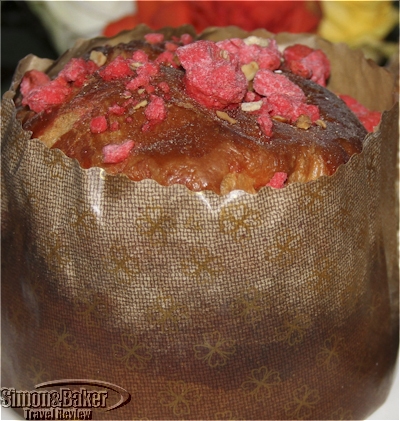
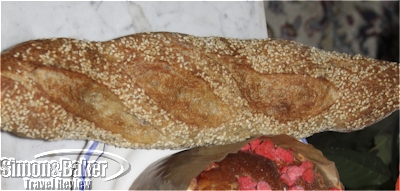
A praline brioche and a sesame baguette
On our most recent trip to Paris, France we discovered a new bakery, well two new bakeries owned by the same person and company. With so many bakeries in the City of Lights what makes these special? The bread. To be precise the bread, the brioche praline and the bite size chocolate (pistachio and regular) financier cakes. The taste of the baked goods we sampled was outstanding. We later found out the baked goods were made fresh daily with no artificial ingredients, additives or colorants and “all bread is prepared, hand kneaded and baked in-house at each and every Kayser company bakery,” according to a company spokesperson.
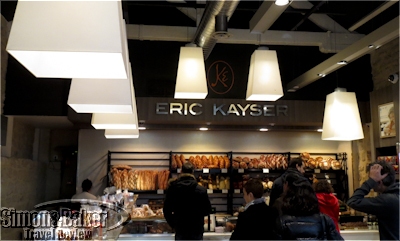
The Maison Kayser shop in Bercy Village
We first went to Maison Kayser Bercy Village (41, cour Saint-Emilion, 75012 Bercy Village, +33 01 43 46 08 89) in the twelfth arrondissement, a bakery with restaurant seating indoors and a shaded outdoor terrace. Since it was winter the outdoor area was vacant but the indoor dining room was popular. We arrived before lunch on a Sunday and were glad we had a reserved table. A steady flow of customers filled the bakery while hungry patrons claimed tables in the dining room. By the time we left it was getting crowded.
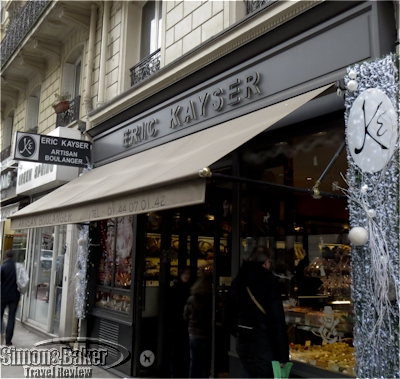
The shop entrance on rue Monge in the Latin Quarter
The following week, we made our way to the shop on Rue Monge (8, rue Monge, 75008, Paris, +33 01 44 07 01 42) in the Latin Quarter, one of twenty-one shops in Paris and 100 overall, in search of more good bread nearer our accommodations. While there the brioche praline, a large brioche topped with bright red sticky bits (we later found some of the sweet and crunchy substance within the brioche), peaked our interest enough to carry it home along with a 200 gram bag of chocolate financiers. We had fallen in love with the bite size cakes made with almond flower and brown butter when we sampled them the previous Sunday at Bercy Village.
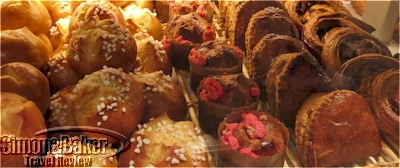
It was difficult to choose
As soon as we arrived home we sliced the bread and brioche, wanting to taste them while they were fresh. The bread, with seeds, was crunchy with a rewarding rich flavor. In the brioche, we were surprised to discover a perfect combination of flavor and texture. It was airy with a mild flavor while the praline filing had just the right amount of sweetness and crunch to make sure there was praline on every slice and pile on extra sometimes.
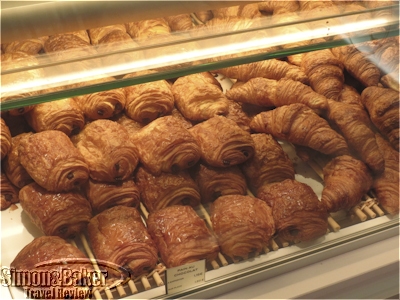
Classic French pastries for sale at Bercy Village
Eric Kayser, the bakery chain’s namesake and the son, grandson and great grandson of bakers, is said to have known from the time he was four years old that he wanted to become a baker and travel. “Being a food lover, manual and curious, I loved to touch the dough, taste the leaven and see how this living element developed during fermentation,” he said by email.
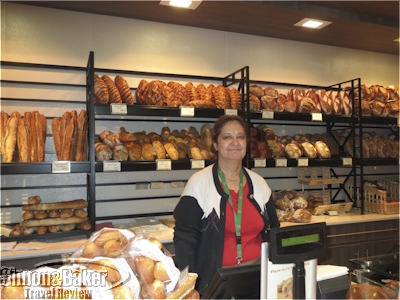
Dalida Gaoua, manager, at the Bercy Village shop
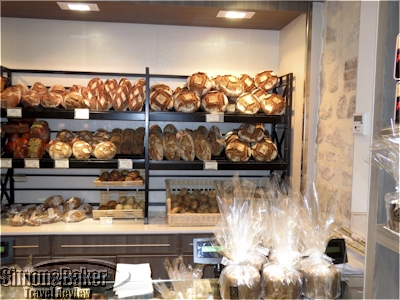
The back wall of the shop was well stocked to supply the steady flow of customers
Kayser began his career at the age of 19 when he went on a baking tour of France for five years. He was attracted, he says, by the bakers “hard working ethos, search for excellence and their ideal of fraternity.” He then taught at the National Bakery school (l’Institut National de la Boulangerie Pâtisserie,INBP) for almost a decade, traveling around France and the world, sharing his knowledge of French traditions.

Tiny round financiers in chocolate and regular were favorites

Tarts and pastries with fruit and chocolate were tempting
He helped many bakeries to open, and then decided to set up shop for himself. After our visit to the rue Monge bakery we discovered that it was his first shop, opened in 1996. Next time we are in Paris, we plan to return for our favorites and sample new products at one of the many Paris locations of Maison Kayser (http://www.maison-kayser.com/en/, contact@maison-kayser.com)
by Editor | Feb 18, 2013 | Attractions, Food and Wine, New Articles
Article and photos by Josette King
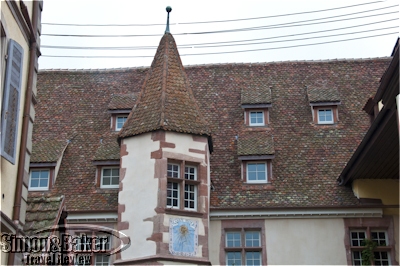
The Courtyard of the Nobles of Berckheim in Riquewihr is an early stone house and turret with sundial
In France, La Route des Vins (The Wine Road) wends its way north to south from Marlenheim (near Strasbourg) to Thann (near Mulhouse) through 170 kilometers (106 miles) of the rolling hills of the Alsatian vineyard. Along the way it reaches over half of the 119 wine-producing villages, with the remainder only a short drive away.
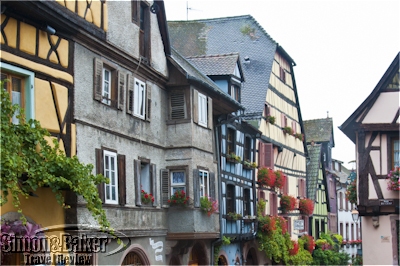
Riquewihr is recognized as one of the most beautiful villages in France for its picturesque medieval architecture
While Alsace traces its viticulture history back to Roman times and many of the villages along La Route des Vins can charm visitors with picturesque architecture reaching back to the Middle Ages, the itinerary itself is a contemporary concept. Intent on rejuvenating Alsatian tourism and refocusing attention on its once famed wine industry, both devastated by the Second World War, the regional tourism office organized an automobile rally on May 30, 1953. All participants departed at the same time, half from Marlenheim and the other half from Thann. Along the way they enjoyed a number of wine tastings and tourist site visits before reaching each other. History doesn’t seem to have recorded which team managed to travel the farthest, but the event proved to be a major success. Thus, La Route des Vins was born. Today, over two million visitors per year come from all corners of Europe and beyond to enjoy the warm welcome of the wine-growing community. Many return time and again to sample the superb wines and gastronomy of the region (paté de foie gras and choucroute garnie originated here).
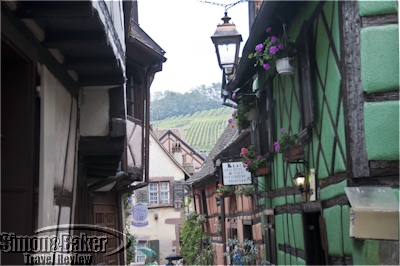
Every break in the roofline offers a glimpse of the vineyards
I was recently one of these return visitors, when I was able to couple a trip to Colmar, the lovely self-appointed capital of the wine road, with a long overdue stop in the nearby village of Riquewihr. It was les vendanges (wine harvest time), and I looked forward to taking a walk up the hill beyond the city walls to the venerable Schoenenbourg Vineyards, reputed since the Middle Ages for producing some of the finest Riesling in the world, and where grapes are still picked by hand. I also planned a leisurely stroll through the historic village with its narrow cobblestone streets lined with centuries-old half-timbered houses. But most of all, I wanted to return to the Hugel & Fils winery (3, rue de la première armée, 68340 Riquewihr, France, +33 (0)3 89 47 92 15, fax +33 (0)3 89 49 00 10, http://www.hugel.com, info@hugel.com), and pay a quiet homage to the memory of a man who almost four decades ago kindled my interest for good wines. Jean Hugel had hosted my first wine tasting in the very cellar where I was now headed. Along with the basics of wine appreciation, he taught me a golden rule by which I still measure wines today.
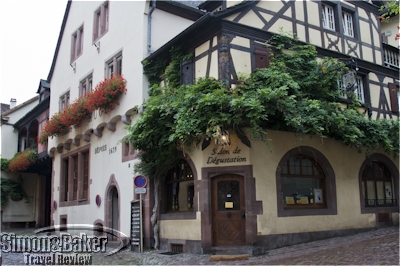
The Hugel Winery headquarters and cellars below
“A good wine,” Jean Hugel told me, “is one that you enjoy when you drink it, still appreciate when you pay for it, and can remember fondly when you wake up the next morning.” He was at the time at the head of Hugel & Fils, one of the most prestigious labels in Alsace, and a family that traces its wine making tradition back 12 generations, to 1639. I was saddened in the summer of 2009 to read his obituary in The New York Times, where he was memorialized as “a leading force in resurrecting the Alsatian wine trade.” I could only nod, and remember his passion as he introduced me to the peerless Hugel Rieslings and Gewurztraminers and most exquisite of all, the nectar-like Vendange Tardive (late harvest) wines. These prestigious wines are made in tiny quantities from overripe grapes picked well after the classic vintage, and in the best years only. These grapes have been affected by botrytis cinerea (a fungus commonly known as pourriture noble, or noble rot). Jean Hugel is credited with writing the rules for the production of Vendange Tardive, which became law in 1984. To this day, no matter where in the world I happen to be, I can never see one of the green fluted bottles with their iconic yellow Hugel label without remembering my host on that long ago afternoon.
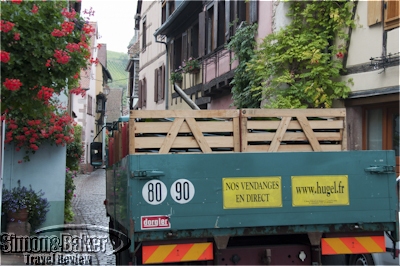
A passing wine harvest truck shows me the way to the Hugel Winery
On the day of my visit, his nephew Etienne Hugel welcomed me to Riquewihr with the same warmth and enthusiasm. Alas, the weather was not so friendly. A cold drizzle had been falling since morning; not a propitious day for a walk to the Schoenenbourg. We headed for the cellars instead, under the meticulously preserved 16th century building of the Hugel headquarters. Along the way, we stopped by the dock where trucks were pulling in with their precious cargo of plump white grapes in plastic tubs. These were immediately brought to the press house, quality tested and selected before being tipped through a funnel designed to gravity-feed them into one of the pneumatic presses on the floor below. The free-run and first pressing juices are then directed, again by gravity only, into stainless-steel vats where they settle overnight to remove solids before the fermentation process begins (Hugel uses only these for its own label. The last pressing is always set aside and sold in bulk). The juice is then gravity-fed into giant oak casks, some over 100 years old, or into stainless steel vats for fermentation.
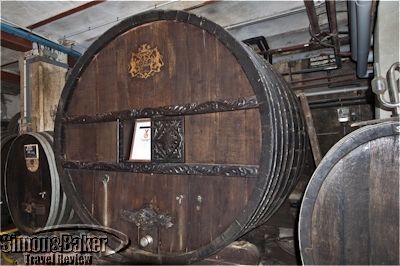
The Sainte Catherine cask dates back to 1715 and is still in use today
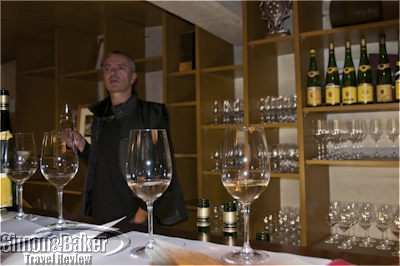
Wine tasting with Etienne Hugel
We continued on, farther into the cellar that reaches deep and wide under the old town. Wines mature there in rows upon impressive rows of huge casks, including the famous Sainte Catherine dating back to 1715, and still in use, before ending our tour in the tasting room. Etienne takes us on a seven-wine graduated tasting with the same verve as his uncle did so many years ago. By the time we get to the Gewurztraminer Jubilee 2008 and the divine Gewurztraminer Vendange Tardive 2005, both from the oldest plots of the Hugel estate in the heart of the Sporen grand cru area, I am ready to break all the rules of wine tasting: I sip, and I swallow. I am certain that Jean Hugel would approve
by Editor | Feb 11, 2013 | Food
By Elena del Valle
Photos by Gary Cox
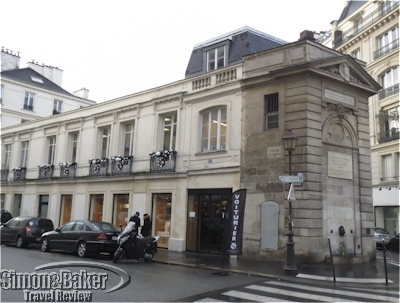
The shop and laboratory share space in this building
Jacques Genin loves chocolate. The self taught fondeur en chocolat, a chocolate maker who works with chocolate mixes (rather than raw cocoa beans), loves to make chocolates, candy and pastries, and eat them. We visited his spacious and modern shop in the Haute Marais neighborhood in Paris, France looking to answer two questions: What could make his shop special in a city riddled with chocolate and pastry shops? Would his products be so good as to draw us across town to the third arrondissement?
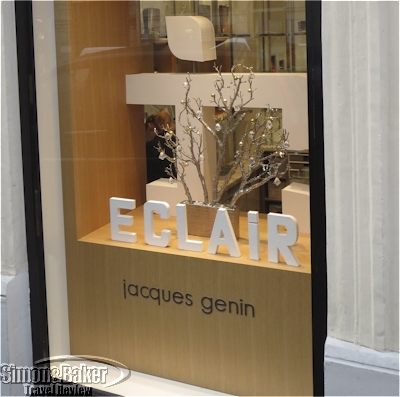
Each window featured one of the product lines
When we first approached the corner shop in a 17th-century double-fronted building we were surprised to see a voiturer or valet service at the entrance. Although we have seen valet service at many upscale shops and gourmet restaurants in Paris it was the first time we noticed one at a chocolate and candy shop. From the outside the window displays, even during the festive end of year season, were understated. As we entered the shop we were greeted by one of a half dozen staff members and directed to a table at the rear corner, behind a spiral staircase where a few minutes later we sampled hot beverages, chocolate and pates de fruit.
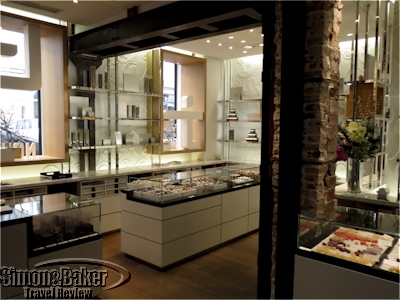
The public area on the ground floor of the shop was designed by Guillaume Leclercq
The busy shop, occupying the bottom part of a 400 square meter space, was uncluttered, organized and elegant. Designed by Guillaume Leclercq the public area featured exposed stone, steel beams and columns, red brick columns, panels of cream plasterwork, oak floors, polished stainless steel and a spiral staircase leading upstairs where the products were made fresh daily.
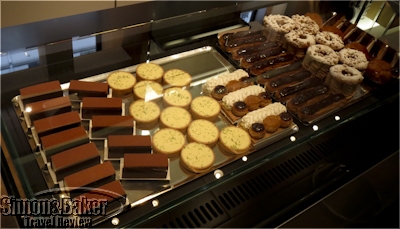
The pastries were made following traditional recipes (click to enlarge)
Friendly staff, some with gloved hands, assisted a steady flow of customers, many of them Japanese. We found out later that one third of the shop customers are from Japan. Near the entrance, there was a check-out counter where customers paid for their purchases after selecting their products at the section of their choice. A handful of steps led down to the main area with glass counters housing old style pastries (our chocolate eclair was delicious), caramels, chocolates, and nougats on the left. Pate de fruit, small sweet fruit paste cubes bursting with flavor, were in a stand alone counter in the middle. A selection of teas and coffee was available as well.
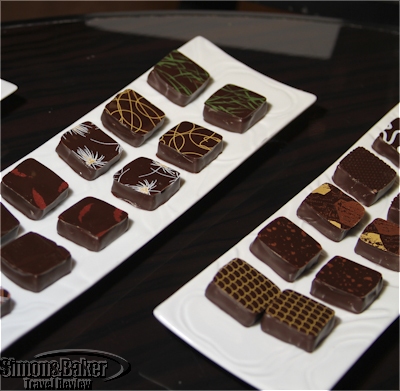
A selection of dark chocolates
So far so good, I thought. It wasn’t until, comfortably seated in leather armchairs next to the staircase, we sampled some of the fifty menu items that we understood what made Jacques Genin products noteworthy. Each bite size morsel had a flavor all its own, intense and unique. These flavors were worth a special effort.
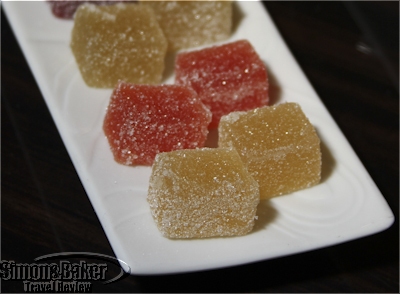
The pates de fruit were exceptional
The pates de fruit, available in nine flavors that day, were the best we have sampled. The flavor combinations, which vary with the season, were harmonious, sometimes unexpected. The ones we tried were were banana, black currant, blood orange, cherry, raspberry and rose, mango and passion fruit, rhubarb, pear and pineapple. To our surprise the pear flavor had a texture reminiscent of, well, pear.
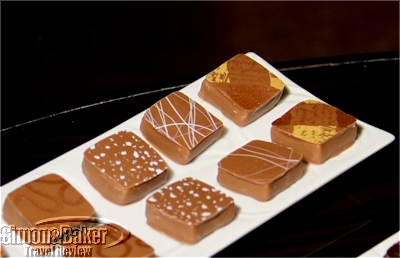
The milk chocolates
The chocolates, made fresh upstairs from 65 percent chocolate, were pretty with a strong distinctive taste. The fragrant ganache filling was well balanced and covered with an outer coat of chocolate, milk or dark. As soon as we bit into a chocolate piece the flavor popped. Moments later, the buttery chocolate joined the ganache in a perfect blend. While the dark chocolates, in the majority, were our favorites the milk chocolates were good as well.
Some of the dark chocolate varieties we sampled were: Mascarille made with Madagascar vanilla; Le beau tenebreux, just dark chocolate; Tonka teck, the tonka bean had an earthy taste; Sucre d’or made with chestnut honey; La belle epineuse with raspberry; Menthe amante (a favorite); Un grain with Szechuan pepper; Caravelle with mild spices; Rousse with cinnamon; C’est Noel with gingerbread; Bergame with bergamot; The toi with tea; Orangelique with orange; and Basilic instinct (a favorite).

The caramels, like the chocolates and pates de fruit, were flavor filled
Jacques Genin products are natural and fresh, never frozen, the owner explained. To obtain the most natural flavors he prefers to infuse plants and spices. As a result the chocolates have a short shelf life. For example, our box of chocolates from December 18 expired January 3. We ate the chocolates past their expiration date, and while they were perfectly eatable and buttery the strong distinctive flavors we had loved at the shop had slowly faded.
Some of the chocolates and candy tasted familiar like the mango and passion fruit caramel. It was no wonder since Jacques Genin used to sell his products to two hundred hotels and gourmet restaurants before he opened the shop in 2009.
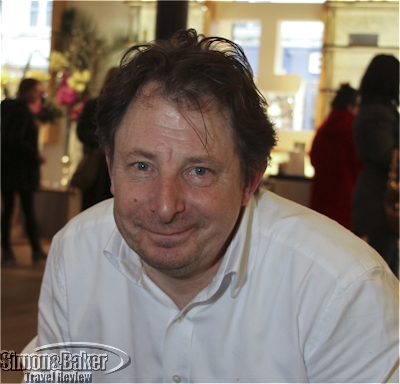
Jacques Genin was first drawn to chocolates for his daughter
As soon as he sat down to chat with us Jacques Genin, a reserved middle aged man who came alive when discussing his passion for chocolates and candy, began popping chocolates from our tasting tray into his mouth. When we asked which ones we should sample first and if there was a perfect order he smiled, reached for another chocolate and explained we should try them at random and simply enjoy them. When I wondered where the best chocolate came from he answered unequivocally, “Venezuela.”
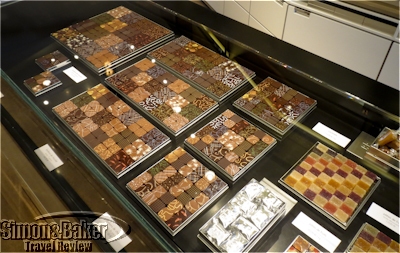
The chocolate and pates de fruit were sold in metal containers to keep them fresh (click to enlarge)
Genin, a chef originally, began making chocolates for his young daughter and over time the business took over his life. It was evident to us that he loved the products he made and looked forward to arriving at work every day, a man who worked for passion and pleasure rather than to make a living or only to make money. The payoff was in the fresh and uniquely flavored chocolates and candy we sampled. The answer to both of the questions we had on arrival was yes. Chocolaterie Jacque Genin (133 rue de Turenne, 75003 Paris, France +33 1 45 77 29 01, contact@jacquesgenin.fr) became a favorite stopping point in our gourmet wanderings in Paris.
by Editor | Feb 4, 2013 | Accomodations, New Articles
Article and photos by Josette King
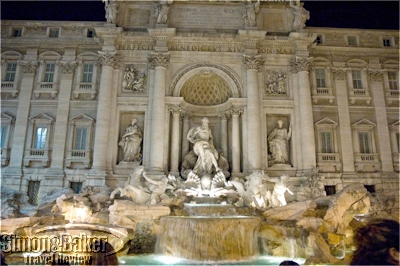
The Trevi Fountain at night
On my first visit to Rome many decades ago I threw the obligatory coin over my shoulder into the Trevi Fountain. It worked. Every few years I seem to come across a new opportunity to return, any excuse will do. Most recently, it was a fortuitous three-day stopover during an extended tour of the region. I deliberately had no agenda other than roaming around the city to soak up the atmosphere of a few favorites spots, and discover new ones along the way. Located in the center of Rome, a five-minute walk from Stazione Termini (Termini for short), the central train station, bus terminal and subway station, and within walking distance from most of the major tourist landmarks, the Hotel Mediterraneo first caught my attention as an ideal base for my explorations; and quickly intrigued me for its Art Deco origins, an architectural style I had not until now associated with the Eternal City.
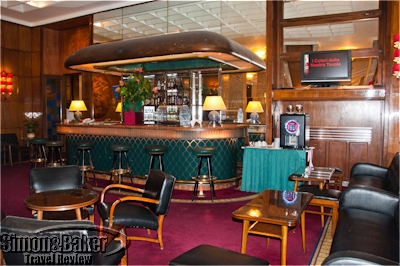
The bar at the Hotel Mediterraneo
Designed in 1936 by noted architect Mario Loreti for Maurizio Bettoja (then head of Bettoja Hotels), the property opened in 1942. To this day it remains the flagship of Bettoja Hotels, one of the oldest and largest family-owned hotel groups in Italy, now in its fifth generation. And with its original grandeur meticulously maintained by Maurizio’s successors, some consider the Mediterraneo among the finest examples of Art Deco architecture and rationalist design in Rome.
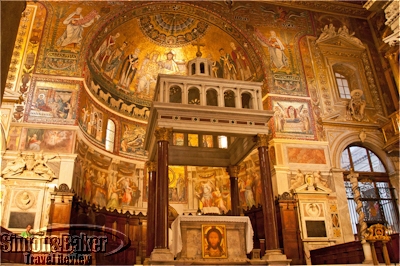
The Santa Maria Maggiore high altar
After a day of wandering through churches and palazzos filled with lavish millennia-old frescoes and extravagantly ornate carvings dripping with gold, the slick polished marble columns and exotic woods paneling of the airy and somewhat austere public spaces characteristic of the Art Deco style were a relaxing contrast. Common areas were filled with remarkable decorative elements of the era, and subtle reminders that, rationalism notwithstanding, eternal Rome endured.
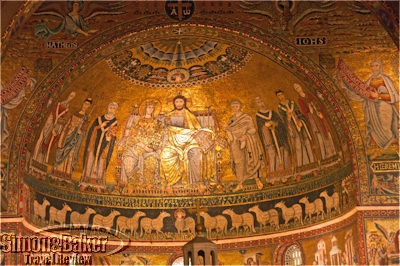
High altar Byzantine mosaic detail at Santa Maria Maggiore
In the lounge, a wall-size parchment map of an ancient perspective of the Mediterranean Sea was a reminder of the property’s name, as well as a nod to the Gallery of Maps at the Vatican. In the dining room, a stunning mosaic of a medieval hunt brought to mind the splendid tapestries of Renaissance palaces. Then there were the museum-worthy marble busts of Roman emperors interspersed throughout. I enjoyed walking through the majestic spaces and discovering new artistic details that had previously escaped my attention.
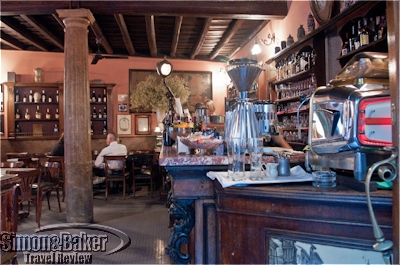
The Caffe della Pace
Although I discovered a new Rome favorite spot at the Mediterraneo, I didn’t neglect my old friends. I paid a neighborly visit to Santa Maria Maggiore. Built in the fifth century, this ancient Basilica still glows from the gold of byzantine mosaics that cover its triumphal arch and high altar. I headed to the Trevi Fountain for a quick nod of thanks. I couldn’t resist dropping by the Pantheon where for a few euros, tourists from around the world have their pictures taken with centurions in crimson capes and plastic armors. I stepped inside as well, to stand under the perfect rotunda and look up at the sky through its central oculus.
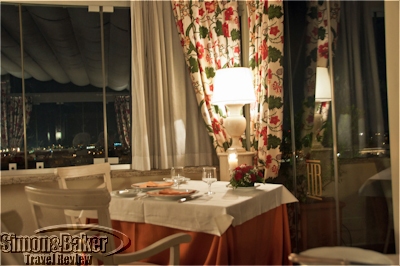
The Hotel Mediterraneo Roof Garden dining room at dinnertime
I went to Piazza Navona to take a fresh look at Bernini’s Fountain of the Four Rivers, which had been under wraps for repairs on two previous visits. Then I wandered into the old streets behind the Piazza, to the Caffe della Pace, a neighborhood favorite for over a century, in the street of that lent it its name, for a Spritz (popular local cocktail made of dry white wine, sparking water and bitter Aperol).
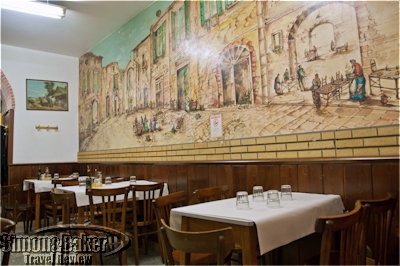
A favorite no-name fish eatery near Campo de Fiori
Thus reinvigorated I continued down the street to Santa Maria della Pace (Saint Mary of Peace) for a glimpse at the exquisite Raphael frescoes in the Chigi Chapel. I visited Campo de Fiori for the daily open market and the surrounding back streets where traditional artisans and avant-garde designers share the narrow storefronts and cobbled courtyards. And I stopped at a hole-in-the-wall fish place with paper tablecloths where market vendors drop in for a quick bite over high-decibel conversation, and neighborhood residents dash in for take-home fried fish. I don’t believe it has a name, but the fried calamari was out of this world.










































